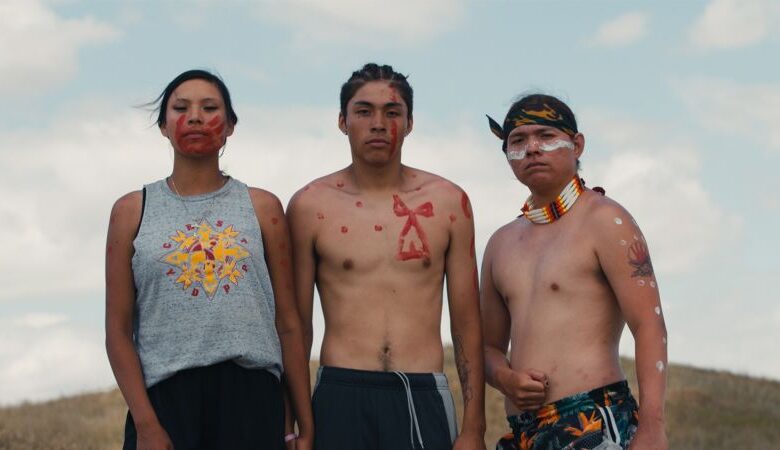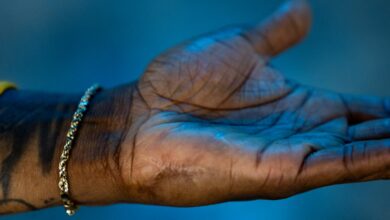The fight for the sacred Black Hills of South Dakota takes center stage in the documentary ‘Lakota Nation vs. United States’

CNN
—
Jesse Short Bull grew up a mile from an Indian reservation in South Dakota not realizing the ground he was stepping on was once soaked with the blood of his ancestors.
Less than a century ago, the Indigenous people of the Lakota Dakota Nakota Nation were killed defending themselves from the United States government, which broke a treaty that vowed the sacred lands, including the Black Hills, would belong to the tribes forever.
“I was like any other kid in America. The real history didn’t exist to me. I had no clue, and the truth was never taught to us,” Short Bull, whose Lakota name is Mni Wanca Wicapi (Ocean Star), told CNN. “When I became older, I wanted to understand what happened and why, and I started to fill in all the missing pieces.”
These missing pieces, which led to Short Bull’s revelation of the violent injustices that led to the creation of South Dakota, is the topic of his documentary, “Lakota Nation vs. United States,” which was released Friday.
The documentary, co-produced by actor Mark Ruffalo, is an in-depth and seldom-heard account of American history – a history that begins with the theft of land and the sacrifice of the Indigenous people who refused to surrender it.
“This film is very much a push for land back, for the return of land, there’s no misunderstanding that’s what they’re looking for,” said film co-director Laura Tomaselli.
IFC Films
A still from the documentary “Lakota Nation vs the United States” shows protestors demanding land be returned to the Indigenous people.
Woven together by interviews with community leaders and activists, historical footage and racist Hollywood film depictions, the IFC Films documentary is split into three parts: extermination, assimilation and reparations.
“It’s not about being angry, it’s not about being bitter. It’s about a lot of people appreciating this country and its constitution. Not realizing our treaty, which was bound to that constitution, is negated to being an old dusty antique that has no meaning,” Short Bull said. “Nothing exists to them from our country or our land or our people. But to us, it exists. We’re real.”
The documentary, elegantly narrated by Oglala Lakota poet Layli Long Soldier, begins with a string of broken treaties by the federal government.
Within the land legally protected by these treaties are the Black Hills, a holy site described in the film by Milo Yellow Hair, an Oglala Lakota elder and activist, as “our cradle of civilization, the heart of everything that is.”
The Black Hills are a place of emergence, the birthplace of dozens of Indigenous tribes who consider it to be the most sacred place in the world.
“It is one of the oldest places on the Earth, over 5 billion years old,” Yellow Hair said. “So we say from the Black Hills and the Wind Cave is that place, that opening on this mother Earth that breathes.”
When gold was discovered on this land in 1851, war broke out for 17 years, forcing Indigenous leaders to fight gun-holstered soldiers with bows and arrows.
In 1868, in efforts to make peace after consistently losing battles against Indigenous tribes, the US government signed the Treaty of Fort Laramie. The treaty designated millions of acres west of the Missouri River for the absolute and undisturbed use and occupation of the Great Sioux Nation, which encompasses over a dozen tribes.
The treaty says the US government “solemnly agrees that no person, except those herein designated and authorized so to do…shall ever be permitted to pass over, settle upon, or reside in the territory described in this article.”
But it became another broken promise.
In 1980, the US Supreme Court ordered over $100 million to be paid to the Great Sioux Nation because of the broken treaty. But the nation hasn’t taken the money. Since 1980 that original $100 million has accrued interest and grown to more than $2 billion.
Patrick Gorski/NurPhoto/Getty Images
The Black Hills of South Dakota, a holy site for dozens of Indigenous tribes who are fighting to see the land returned to them.
But despite the poverty they face, the Great Sioux Nation still refuses the money. Because the land was never for sale.
“We are nothing without the Black Hills, that’s why the Black Hills are not for sale, because we are not for sale,” Sicangu Lakota historian Nick Estes says in the documentary. “How can you sell your very identity of what makes you an Indigenous person?”
The documentary also offers in-depth analysis into forced assimilation tactics deployed by the US government to weaken Lakota Dakota Nakota tribes who were still fighting back. One method was killing off their buffalo and depleting their resources, so they began to starve and had no choice but to depend on the government, according to the film.
Another method was taking away their children and enrolling them in boarding schools, stripping them of their Indigenous names and clothing, banning them from speaking their languages and forcing them to cut their hair. If they resisted, they were punished, often violently.
With the intention of conquering their people by destroying their culture, says Oglala Lakota activist Nick Tilsen, “they outlawed our language, they made our ceremonies illegal, they criminalized us for living our way of life.”
After premiering at the Tribeca Film Festival in June 2022, “Lakota Nation vs. United States” has played on the screens at Indigenous reservations where the tragic story takes place.
At Standing Rock Sioux Reservation, nearly 200 people, including elders who still carry stories of dark days, attended the screening, and many were in tears, says Hunkpapa Lakota elder Cedric Good House.
“We were impressed with Jesse and everybody else because it took real bravery to do this, a lot of courage,” Good House told CNN. “It’s coming at a time when people think they can know it all in a matter of a minute. They’ll read a little clip on Facebook and that’s it.”
“But here is this lengthy documentary and people are getting captivated by the truth, and after they finish watching they can see this is still applicable to us today. We can point it out for them,” he continued. “Look what’s happening today here and here and here, we are still fighting.”
The Standing Rock Sioux have been recently entangled in another battle against the federal government, mainly the US Army Corps of Engineers, the agency responsible for approving the Dakota Access Pipeline.
A violation of the Treaty of Fort Laramie, the pipeline is a 1,172-mile underground conduit that would transport some 470,000 barrels of crude oil a day – stretching across North Dakota, South Dakota, Iowa and Illinois.
The Standing Rock Sioux, whose reservation resides near where the pipeline runs, say it will not only endanger their main source of drinking water – the Missouri River – but also their sacred tribal grounds.
“This movie is about our history, but here in the present we see nothing has changed,” Good House said. “This is our sacred land, and we try to get ourselves into the process, but the process still doesn’t address us.”
In a desperate fight to protect their land and Unci Maka, or Mother Earth, Native tribal members alongside non-Indigenous allies and environmentalists demonstrated for years against the construction of the oil pipeline until they were forcibly removed from the protest site in 2017.
“We’re not here to chase people off land. We’re not here to take over their farms and ranches and start charging people for crossing our territory,” Good House said. “We are protecting this Earth, we’re not here to do what the government has done to us.”
In the land where ceremonies were once held and their ancestors bones now lay, Indigenous holy sites are still being exploited for profit, elders and activists say in the film.
After killing those who attempted to protect it, the US government has turned stolen land into tourist attractions, Short Bull says, making money off the ongoing pain and suffering of Lakota Dakota Nakota tribes.
Deep in the Black Hills stands a mountain known as the Six Grandfathers, or Tȟuŋkášila Šákpe, whose peaks were blown up to carve the faces of four presidents – now known as the Mount Rushmore National Memorial.
IFC Films
Mt. Rushmore, in Keystone, South Dakota, is carved into the Black Hills, which had been occupied by Lakota Sioux Natives.
“Mount Rushmore represents and is the ultimate shrine to White supremacy,” activist Krystal Two Bulls of the Northern Cheyenne and Oglala Lakota says in the film. “Our sacred mountain, the Six Grandfathers, of course they carved four racist White men into our sacred mountain, who believed in slavery, who actually removed us from our lands.”
Today the children of the Indigenous leaders who died to preserve whatever land they could continue their ancestors’ purpose: demanding their land back.
And as the world suffers a climate crisis where Indigenous traditions, like controlled burning, are now being used to fight it, “it’s a no brainer” to return the land to those who can actually care for it, says Tomaselli, the film’s co-director.
“If you are a non Indigenous person and you’re concerned about the climate, it should be obvious to throw all of your energy behind people that were living here before any of our ancestors showed up, tribes who have been taking care of this environment better than anyone has before,” Tomaselli said.
As calamities happen around them for the sake of money, Short Bull says – gold mining, coal mining, the pipeline development, deforestation – the Indigenous people living there still have no say.
But with their demand for land back comes a warning.
“I want people to remember that there is bloodshed on Earth and our relatives’ blood is on this ground,” Short Bull said. “This planet was not created for you to just take, take, take. The Earth is an extension of you, and if you’re not going to take care of it, disaster is coming.”























































